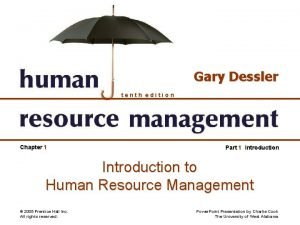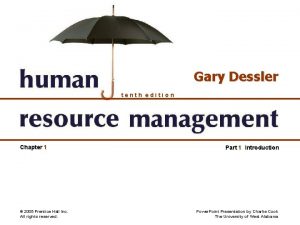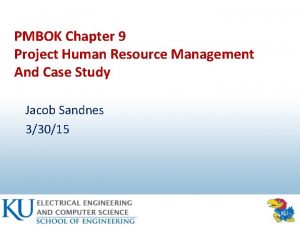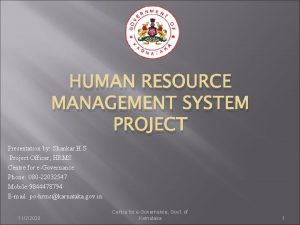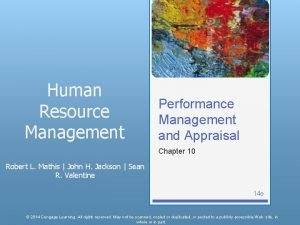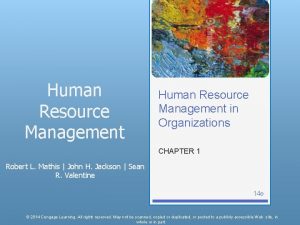Human Resource Management ELEVENTH EDITION 1 GARY DESSLER






































- Slides: 38

Human Resource Management ELEVENTH EDITION 1 GARY DESSLER Part 3 | Training and Development Chapter 9 Performance Management and Appraisal Power. Point Presentation by Charlie Cook The University of West Alabama

After studying this chapter, you should be able to: 1. Evaluate and improve the appraisal form in Figure 9 – 1. 2. Describe the appraisal process. 3. Develop, evaluate, and administer at least four performance appraisal tools. 4. Explain and illustrate the problems to avoid in appraising performance. 5. List and discuss the pros and cons of six appraisal methods. 6. Perform an effective appraisal interview. 7. Discuss the pros and cons of using different raters to appraise a person’s performance. © 2008 Prentice Hall, Inc. All rights reserved. 2

Basic Concepts in Performance Management and Appraisal Comparing Performance Appraisal and Performance Management Performance Appraisal: Setting work standards, assessing performance, and providing feedback to employees to motivate, correct, and continue their performance. © 2008 Prentice Hall, Inc. All rights reserved. Performance Management: An integrated approach to ensuring that an employee’s performance supports and contributes to the organization’s strategic aims. 3

Why Performance Management? Total Quality The Performance Management Approach Appraisal Issues Strategic Focus © 2008 Prentice Hall, Inc. All rights reserved. 4

Defining the Employee’s Goals and Work Standards Guidelines for Effective Goal Setting Assign Specific Goals Assign Measurable Goals © 2008 Prentice Hall, Inc. All rights reserved. Assign Challenging but Doable Goals Encourage Participation 5

Setting Goals • SMART Goals: Ø Specific, and clearly state the desired results. Ø Measurable in answering “how much. ” Ø Attainable, and not too tough or too easy. Ø Relevant to what’s to be achieved. Ø Timely in reflecting deadlines and milestones. © 2008 Prentice Hall, Inc. All rights reserved. 6

Performance Appraisal Roles • Supervisors Ø Usually do the actual appraising. Ø Must be familiar with basic appraisal techniques. Ø Must understand avoid problems that can cripple appraisals. Ø Must know how to conduct appraisals fairly. © 2008 Prentice Hall, Inc. All rights reserved. 7

Performance Appraisal Roles (cont’d) • The HR Department Ø Serves a policy-making and advisory role. Ø Provides advice and assistance regarding the appraisal tool to use. Ø Trains supervisors to improve their appraisal skills. Ø Monitors the appraisal system effectiveness and compliance with EEO laws. © 2008 Prentice Hall, Inc. All rights reserved. 8

An Introduction to Appraising Performance Why Appraise Performance? 1 Is basis for pay and promotion decisions. 2 Plays an integral role in performance management. 3 Helps in correcting deficiencies and reinforcing good performance. 4 Is useful in career planning. © 2008 Prentice Hall, Inc. All rights reserved. 9

(Un)Realistic Appraisals • Motivations for Soft Appraisals Ø The fear of having to hire and train someone new. Ø The unpleasant reaction of the appraisee. Ø An appraisal process that’s not conducive to candor. • Hazards of Soft Appraisals Ø Employee loses the chance to improve before being forced to change jobs. Ø Lawsuits arising from dismissals involving inaccurate performance appraisals. © 2008 Prentice Hall, Inc. All rights reserved. 10

An Introduction to Appraising Performance Steps in Appraising Performance 1 Defining the job 2 Appraising performance 3 Providing feedback © 2008 Prentice Hall, Inc. All rights reserved. 11

Designing the Appraisal Tool • What to Measure? Ø Work output (quality and quantity) Ø Personal competencies Ø Goal (objective) achievement • How to Measure? Ø Generic dimensions Ø Actual job duties Ø Behavioral competencies © 2008 Prentice Hall, Inc. All rights reserved. 12

FIGURE 9– 3 Sample Performance Rating Form Source: Elaine Pulakos, Performance Management (SHRM Foundation, 2004) p. 16– 17. Reprinted by permission of Society for Human Resource Management via Copyright Clearance Center. © 2008 Prentice Hall, Inc. All rights reserved. 13

FIGURE 9– 3 Sample Performance Rating Form (cont’d) Source: Elaine Pulakos, Performance Management (SHRM Foundation, 2004) p. 16– 17. © 2008 Prentice Hall, Inc. All rights reserved. 14

FIGURE 9– 4 Portion of an Administrative Secretary’s Performance Appraisal Form Showing Task(s) to Appraise © 2008 Prentice Hall, Inc. All rights reserved. 15

Performance Appraisal Methods Appraisal Methodologies 1 Graphic Rating Scale Method 6 Narrative Forms 2 Alternation Ranking Method 7 Behaviorally Anchored Rating Scales (BARS) 3 Paired Comparison Method 8 Management by Objectives (MBO) 4 Forced Distribution Method 9 Computerized and Web-Based Performance Appraisal 5 Critical Incident Method 10 Merged Methods © 2008 Prentice Hall, Inc. All rights reserved. 16

FIGURE 9– 6 Scale for Alternate Ranking of Appraisees © 2008 Prentice Hall, Inc. All rights reserved. 17

FIGURE 9– 8 Appraisal. Coaching Worksheet Source: Reprinted from www. HR. BLR. com with permission of the publisher Business and Legal Reports, Inc. 141 Mill Rock Road East, Old Saybrook, CT © 2004. © 2008 Prentice Hall, Inc. All rights reserved. 18

Behaviorally Anchored Rating Scale (BARS) Developing a BARS 1. Generate critical incidents 2. Develop performance dimensions 3. Reallocate incidents 4. Scale the incidents Advantages of BARS Ø A more accurate gauge Ø Clearer standards Ø Feedback Ø Independent dimensions Ø Consistency 5. Develop a final instrument © 2008 Prentice Hall, Inc. All rights reserved. 19

FIGURE 9– 9 Example of a Behaviorally Anchored Rating Scale for the Dimension Salesmanship Skills © 2008 Prentice Hall, Inc. All rights reserved. 20

Management by Objectives (MBO) • A comprehensive and formal organizationwide goal-setting and appraisal program requiring: 1. Setting of organization’s goals. 2. Setting of departmental goals. 3. Discussion of departmental goals. 4. Defining expected results (setting individual goals). 5. Conducting periodic performance reviews. 6. Providing performance feedback. © 2008 Prentice Hall, Inc. All rights reserved. 21

Using MBO Setting unclear objectives Time-consuming appraisal process Problems with MBO Conflict with subordinates over objectives © 2008 Prentice Hall, Inc. All rights reserved. 22

Appraising Performance: Problems and Solutions Potential Rating Scale Appraisal Problems Unclear Standards Halo Effect © 2008 Prentice Hall, Inc. All rights reserved. Central Tendency Leniency or Strictness Bias 23

TABLE 9– 2 A Graphic Rating Scale with Unclear Standards Excellent Good Fair Poor Quality of work Quantity of work Creativity Integrity Note: For example, what exactly is meant by “good, ” “quantity of work, ” and so forth? © 2008 Prentice Hall, Inc. All rights reserved. 24

FIGURE 9– 10 Sample Rating Errors Focusing on one or two critical incidents Lower rating for less challenge Nobody can be that good (Strictness) Similarity Being influenced by prior performance Rating for retention Style differences Emotional rating Recent performance only Friendships © 2008 Prentice Hall, Inc. All rights reserved. 25

Appraising Performance: Problems and Solutions (cont’d) How to Avoid Appraisal Problems Know Problems Use the Right Tool © 2008 Prentice Hall, Inc. All rights reserved. Train Supervisors Control Outside Influences Keep a Diary 26

TABLE 9– 3 Important Advantages and Disadvantages of Appraisal Tools Tool Advantages Graphic rating scale Simple to use; provides a Standards may be unclear; halo quantitative rating for each employee. effect, central tendency, leniency, bias can also be problems. BARS Provides behavioral “anchors. ” BARS is very accurate. Difficult to develop. Alternation ranking Simple to use (but not as simple as graphic rating scales). Avoids central tendency and other problems of rating scales. Can cause disagreements among employees and may be unfair if all employees are, in fact, excellent. Forced distribution method End up with a predetermined number or % of people in each group. Employees’ appraisal results depend on your choice of cutoff points. Critical incident method Helps specify what is “right” and “wrong” about the employee’s performance; forces supervisor to evaluate subordinates on an ongoing basis. Difficult to rate or rank employees relative to one another. MBO Tied to jointly agreed-upon performance objectives. Time-consuming. © 2008 Prentice Hall, Inc. All rights reserved. Disadvantages 27

Who Should Do the Appraising? Immediate Supervisor Peers Rating Committee © 2008 Prentice Hall, Inc. All rights reserved. Self-Rating Potential Appraisers Subordinates 360 -Degree Feedback 28

The Appraisal Interview Satisfactory—Promotable Satisfactory—Not Promotable Types of Appraisal Interviews Unsatisfactory—Correctable Unsatisfactory—Uncorrectable © 2008 Prentice Hall, Inc. All rights reserved. 29

The Appraisal Interview (cont’d) Guidelines for Conducting an Interview Talk in terms of objective work data. © 2008 Prentice Hall, Inc. All rights reserved. Don’t get personal. Encourage the person to talk. Don’t tiptoe around. 30

The Appraisal Interview (cont’d) How to Handle a Defensive Subordinate 1 Recognize that defensive behavior is normal. 2 Never attack a person’s defenses. 3 Postpone action. 4 Recognize your own limitations. © 2008 Prentice Hall, Inc. All rights reserved. 31

The Appraisal Interview (cont’d) How to Criticize a Subordinate 1 Do it in a manner that lets the person maintain his or her dignity and sense of worth. 2 Criticize in private, and do it constructively. 3 Give daily feedback so that the review has no surprises. 4 Never say the person is “always” wrong. 5 Criticism should be objective and free of biases. © 2008 Prentice Hall, Inc. All rights reserved. 32

The Appraisal Interview (cont’d) How to Ensure Improved Performance 1 2 3 Don’t make the subordinate feel threatened during the interview. Give the subordinate the opportunity to present his or her ideas and feelings. Give daily feedback so that the review has no surprises. 4 Never say the person is “always” wrong. 5 Criticism should be objective and free of biases. © 2008 Prentice Hall, Inc. All rights reserved. 33

FIGURE 9– 11 Performance Contract Source: David Antonion, “Improving the Performance Management Process Before Discontinuing Performance Appraisals, ” Compensation and Benefits Review May–June 1994, p. 33, 34. Reprinted by permission of Sage Publications, Inc. © 2008 Prentice Hall, Inc. All rights reserved. 34

FIGURE 9– 12 Checklist During the Appraisal Interview © 2008 Prentice Hall, Inc. All rights reserved. 35

Formal Written Warnings • Purposes of a Written Warning Ø To shake your employee out of bad habits. Ø To help you defend your rating, both to your own boss and (if needed) to the courts. • A Written Warning Should: Ø Identify standards by which employee is judged. Ø Make clear that employee was aware of the standard. Ø Specify deficiencies relative to the standard. Ø Indicate employee’s prior opportunity for correction. © 2008 Prentice Hall, Inc. All rights reserved. 36

Creating the Total Performance Management Process • “What is our strategy and what are our goals? ” • “What does this mean for the goals we set for our employees, and for how we train, appraise, promote, and reward them? ” © 2008 Prentice Hall, Inc. All rights reserved. 37

KEY TERMS performance appraisal performance management graphic rating scale alternation ranking method paired comparison method forced distribution method critical incident method behaviorally anchored rating scale (BARS) © 2008 Prentice Hall, Inc. All rights reserved. management by objectives (MBO) electronic performance monitoring (EPM) unclear standards halo effect central tendency strictness/leniency bias appraisal interview 38
 Gary dessler human resource management
Gary dessler human resource management Management eleventh edition
Management eleventh edition Management stephen p robbins 11th edition
Management stephen p robbins 11th edition Management eleventh edition
Management eleventh edition Management eleventh edition
Management eleventh edition Gary dessler hrm notes
Gary dessler hrm notes Gary dessler
Gary dessler Roi metrics
Roi metrics Management fifteenth edition
Management fifteenth edition International human resource management dowling 6th edition
International human resource management dowling 6th edition Human resource management fifteenth edition
Human resource management fifteenth edition Workforce and demographic trends in hrm
Workforce and demographic trends in hrm Time management human resources
Time management human resources Organizational chart for retail business
Organizational chart for retail business Human resources defintion
Human resources defintion Eleventh 5 year plan
Eleventh 5 year plan Eleventh 5 year plan
Eleventh 5 year plan Eleventh plan
Eleventh plan For his eleventh birthday elvis presley
For his eleventh birthday elvis presley White e lippitt propõem três estilos de liderança
White e lippitt propõem três estilos de liderança Rudolf dessler
Rudolf dessler Hr strategy map
Hr strategy map Dessler 2005
Dessler 2005 Project human resource management pmbok ppt
Project human resource management pmbok ppt Resource management pmbok
Resource management pmbok Importance of human resource management
Importance of human resource management Recruitment process of max's restaurant
Recruitment process of max's restaurant Definition of induction in hrm
Definition of induction in hrm Human resource management chapter 2
Human resource management chapter 2 Chapter 9 human resource management
Chapter 9 human resource management Hrms.shanker group
Hrms.shanker group Mbo performance appraisal method
Mbo performance appraisal method Current issues in human resource management
Current issues in human resource management Ba human resource management
Ba human resource management Purpose of human resource management
Purpose of human resource management Human resource management gaining a competitive advantage
Human resource management gaining a competitive advantage Downsizing
Downsizing Human resource management gaining a competitive advantage
Human resource management gaining a competitive advantage Exam questions on human resource development
Exam questions on human resource development







